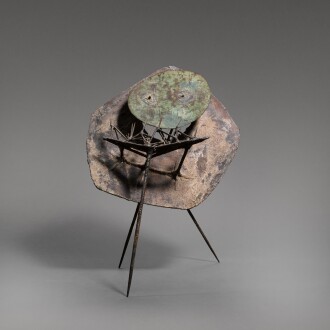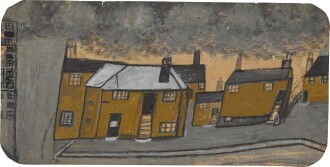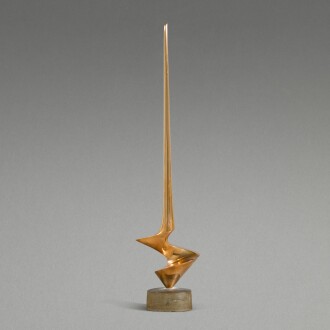W e are delighted to present a superb selection of 20th-century British art for our November sale. Led by Barbara Hepworth’s unique Small Form (November), Britain’s sculptors are especially well-represented, including examples from two distinct private collections, A Sense of Form: Property from a Private British Collection and Ground Breaking: Works from the Collection of Joseph & Blanche Blank, featuring Lynn Chadwick, Kenneth Armitage, Reg Butler, Robert Adams, Bernard Meadows, William Turnbull and Denis Mitchell.
Paintings by Alfred Wallis, Ben Nicholson, Christopher Wood and Cedric Morris showcase English Modernism from the late 1920s while Britain’s post-War abstract painters are represented by Peter Lanyon, Patrick Heron, William Scott, Alan Davie, Roger Hilton and Ivon Hitchens. Elsewhere are significant early 20th-century paintings by Robert Bevan, William Orpen, Stanley Spencer and Winston Churchill through to works by Lucian Freud, Howard Hodgkin, Bridget Riley and Antony Gormley at the end of the century.
Tour the Virtual Exhibition
Sale Highlights

Barbara Hepworth's Spiritual Masterpiece
Discover the perfect evocation of Barbara Hepworth’s art. ‘Small Form (November)’ is a perfectly balanced sculpture, the size of the artist’s hand, that she made in the early 1960s as she returned to her first love of carving in stone after a decade of working in bronze.
Barbara Hepworth’s Spiritual Masterpiece

Early St Ives and the Influence of Alfred Wallis
‘The most important idea Ben learned from Wallis was how alive and direct his art was, free from self-consciousness and innocently maintaining an intense vision.’
1928 was a seminal year for Modernism in 20th-century British art. Christopher Wood had first met Ben and Winifred Nicholson and Cedric Morris in 1926 in London. Winifred recalled of the meeting: ‘…we were going out to dinner with Jim [Ede] – and somebody was talking with Ben and Cedric down in Ben’s studio. I had no idea who it was, but they went on talking and talking, he with a voice that moved me so strangely.’
Two years later Wood went to stay with the Nicholsons in their Cumbrian farmhouse, Bankshead, and later that summer they stayed together in St Ives. The trio worked together, often side-by-side outside and these months of communal living and work proved transformational, taking inspiration from one another in a flurry of creativity and experimentation. Whilst in St Ives, Ben and Christopher stumbled across the small fisherman’s cottage inhabited by Alfred Wallis and depicted in Wallis’s Houses, Porthmeor Square, lot 301.
Wallis’s naïve paintings of seascapes and fishermen had a profound and lasting impact over the work of Wood and the Nicholsons, who incorporated the folk-like simplicity and directness of this self-taught fisherman’s imagery into their artistic re-imagining of the British countryside.

At the outbreak of World War II, Barbara Hepworth moved from London to Cornwall with Ben Nicholson and their young family in 1939. After the War, she purchased a larger space, Trewyn Studio, where she was to live and work until her death in 1975 – "It is completely perfect for me", she wrote to Philip James, Director of Art at the Arts Council, on 29 August 1949. Over the course of her time there many artists within Cornwall’s thriving artistic community visited Hepworth – either to exchange artistic ideas or to work as assistants and learn directly from a sculptor of her international stature. Many in turn became renowned figures within the generation of post-War British artists that flourished in Cornwall.
Several of these assistants are well represented in A Sense of Form: Property from a Private British Collection, including Denis Mitchell, Keith Leonard and John Milne, and Hepworth herself, whilst works by John Wells and Terry Frost also appear in the sale selection.


























